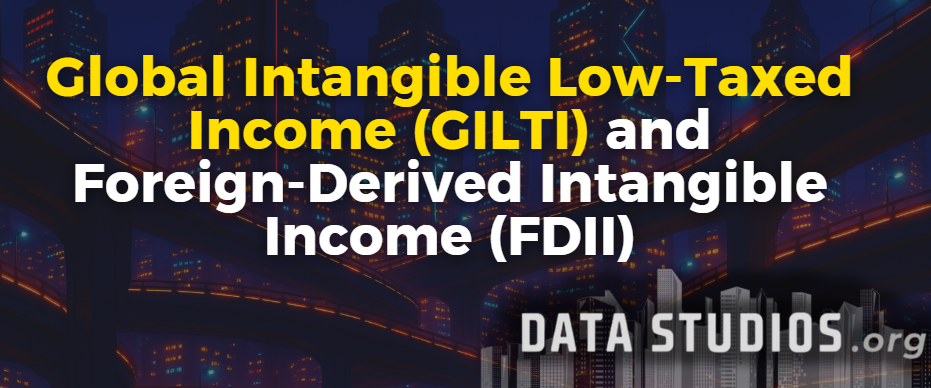Global Intangible Low‑Taxed Income (GILTI) and Foreign‑Derived Intangible Income (FDII)
- Graziano Stefanelli
- Aug 1
- 3 min read

U.S. tax law pairs an anti‑deferral charge on foreign residual profit with a domestic export incentive. The interaction affects corporate cash tax, effective rate forecasts, and financial‑statement provisioning for multinationals that hold valuable intangibles abroad and license them from the United States.
GILTI pulls foreign residual profit into current U.S. tax.
Each controlled foreign corporation calculates tested income, subtracts a 10 percent routine return on qualified business asset investment (QBAI), and allocates the remainder to U.S. shareholders.
A domestic corporation includes its pro‑rata share and claims a 50 percent deduction under § 250 through 31 December 2025, yielding an effective 10.5 percent federal rate before foreign tax credits. Absent legislative extension, the deduction drops to 37.5 percent on 1 January 2026, raising the effective rate to 13.125 percent. Foreign taxes up to 80 percent are creditable but must be blended in a single “GILTI basket,” and interest allocation can erode the credit ceiling.
Illustrative computation — one CFC
Tested income $50 million
QBAI $200 million × 10 % = $20 million
GILTI = $30 million
U.S. inclusion (100 % ownership) $30 million
§ 250 deduction (50 %) $15 million
Net taxable $15 million × 21 % = $3.15 million
Journal entry — year‑end
Dr Income Tax Expense $3 150 000
Cr Income Tax Payable $3 150 000
Deferred taxes arise when local‑GAAP earnings diverge or when high‑tax elections change future credit profiles.
High‑tax exclusion removes items already facing sufficient foreign levy.
An annual election compares effective foreign rates for each qualified group of tested units to 90 percent of the U.S. rate. Excluded amounts bypass GILTI and drop into previously taxed earnings and profits pools.
Groups must model rate fluctuations, foreign incentive regimes, and currency movements; once an exclusion applies, correlative relief is unavailable if the foreign jurisdiction later refunds tax.
FDII offers a deduction for qualifying export income earned in the United States.
A domestic corporation measures foreign‑derived deduction‑eligible income (FDDEI), subtracts 10 percent of its qualified business asset investment, and enjoys a 37.5 percent § 250 deduction through 2025 (dropping to 21.875 percent thereafter).
Where a U.S. parent licenses software to unrelated foreign users, gross receipts qualify so long as usage occurs outside the United States and documentation satisfies § 1.250(b) regulations on “substantiation of foreign use.” FDII turns the combined federal rate on qualifying profit into 13.125 percent through 2025, rising to 16.406 percent from 2026.
Illustrative computation — U.S. exporter
FDDEI $40 million
QBAI $50 million × 10 % = $5 million
FDII = $35 million
§ 250 deduction (37.5 %) $13.125 million
Net taxable $21.875 million × 21 % = $4.594 million
Section 250 deduction mechanics link GILTI and FDII.
A single deduction serves both regimes, requiring a combined taxable‑income limitation. If overall taxable income is insufficient, the § 250 benefit scales down pro rata, often reducing FDII first because GILTI carries foreign‑tax credits.
Planners can shift cost‑sharing payments, elect foreign‑branch treatment, or tweak interest‑allocation methods to stabilise the deduction and preserve credits.
Compliance demands detailed forms and unit‑by‑unit tracing.
Form 8992 reports GILTI; Form 8993 computes the § 250 deduction; Schedule A of Form 5471 feeds tested income and asset data. Mis‑sourcing export receipts or omitting substantiation triggers accuracy penalties and jeopardises FDII eligibility.
Accounting teams should integrate statutory ledgers, intercompany billing engines, and customs data to populate the forms automatically and archive evidence of foreign use.
Financial‑statement impact extends beyond cash taxes.
ASC 740 requires measurement of deferred tax assets for foreign‑tax‑credit carryforwards, valuation allowances where credit limits bite, and uncertain‑tax‑position reserves when high‑tax‑election eligibility or FDII substantiation remains in doubt.
Quarterly provision models must track the looming § 250 deduction sunset, Pillar Two top‑up computations, and the corporate alternative minimum tax, layering each regime without double relief.
Legislative outlook may narrow incentives and adjust rates.
Current Congressional drafts propose conforming GILTI to a country‑by‑country basis and raising the effective rate to 20 percent, while phasing out FDII or replacing it with a refundable research incentive. Finance leaders should run scenario analyses and refresh deferred‑tax disclosures accordingly.
Continuous monitoring of foreign effective rates, disciplined documentation of export receipts, and proactive modelling of pending reforms remain the safest path to stable cash‑tax outcomes under GILTI and FDII.
____________
FOLLOW US FOR MORE.
DATA STUDIOS




